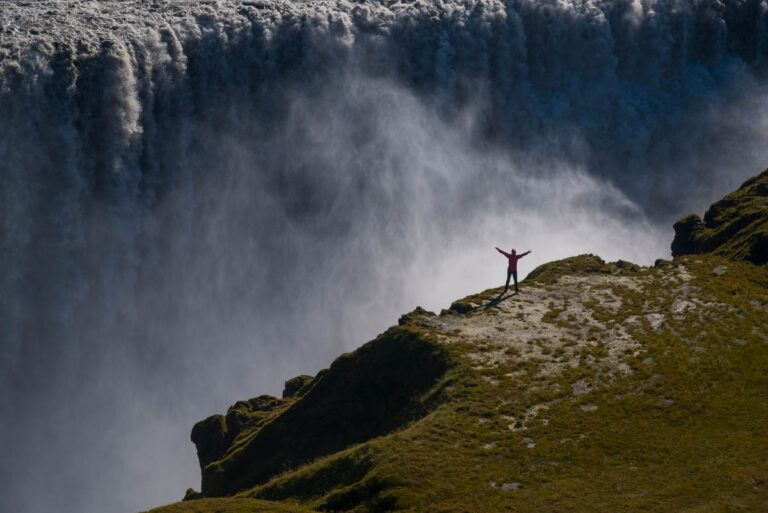Explore Dettifoss: the Most Powerful Waterfall in Europe
- North Iceland
- 27 Jul 2024
Discover Dettifoss, an awe-inspiring spectacle in Iceland's northeastern highlands where raw power and breathtaking beauty collide. Standing tall above the Jökulsárgljúfur canyon, Dettifoss's thunderous roar captivates, offering a mesmerizing glimpse into nature's formidable force.

Dettifoss, Europe’s mightiest waterfall, boasts a staggering flow of 200 cubic meters of water per second as it cascades over the edge. Rising 45 meters high and stretching 100 meters wide, Dettifoss derives its name from the Icelandic words “detta” (meaning “to fall”) and “foss” (meaning “waterfall”), translating literally as “falling waterfall” or “collapsing waterfall”.
Where is Dettifoss
Dettifoss Waterfall is situated in Northeast Iceland in Vatnajökull National Park. It stands on the river Jökulsá á Fjöllum (meaning “glacial river in the mountains”), flowing from Vatnajökull glacier.

Jökulsá á Fjöllum River
The Jökulsá á Fjöllum is the second longest river in Iceland, beginning from the Vatnajökull glacier, Europe’s most voluminous ice cap.
During its journey through the land, the river carves its pathway to create Jökulsárgljúfur, a dramatic canyon that’s host to Dettifoss.
The sheer force of the river is evident as it plunges over the falls, and you witness the mightiest current within this landscape carrying a substantial load of sediment, giving the water its distinctive greyish-white hue.
There are two more waterfalls in Jökulsárgljúfur apart from Dettifoss: Selfoss waterfall upstream and Hafragilsfoss waterfall downstream.

Selfoss and Hafragilsfoss Waterfalls
Selfoss Waterfall is a mere 1km walk upstream from Dettifoss. Although smaller, it boasts an impressive series of cascades that create a stunning panorama, and presents a different character of beauty from its immense neighbor.
Moving downstream, Hafragilsfoss Waterfall, situated approximately 2km from Dettifoss, presenting yet another facet of the Jökulsá á Fjöllum river’s majesty.

Vatnajökull National Park
Vatnajökull National Park, located in southeastern Iceland, is renowned for its vast glaciers, dramatic landscapes, and diverse wildlife. It received its name from Europe’s largest glacier, Vatnajökull. The park offers visitors the chance to explore ice caves, volcanic terrain, and stunning waterfalls, making it a haven for outdoor enthusiasts and nature lovers alike.

Exploring Dettifoss
Before setting foot on the majestic landscapes that surround the waterfall, knowing the optimal times and ways for your visit and how to prepare can greatly improve your experience.
How to get to Dettifoss
Dettifoss is accessible from both its eastern and western sides, each offering marked hiking trails.
From the West:
You can follow paved road number 862, situated between Mývatnsöræfi and Kelduhverfi. It’s important to note that this road has limited winter maintenance.
Hiking trail from Parking Area 1 (West side): A shorter, more maintained path leading directly to the best viewpoints of the falls.
From the East:
You can access Dettifoss via gravel route number 864, though travel can be slow, especially as snowfall begins in autumn, leading to its closure for winter season. The reopening in spring depends on weather and ground conditions, typically when wet mud has sufficiently dried.
Hiking trail from Parking Area 2 (East side): Offers a less crowded experience with more rugged hiking options.
Caution is advised regardless of the chosen route. We suggest checking the Icelandic Road and Coastal Administration website for current road and weather conditions. It’s crucial to wear sturdy, waterproof footwear since trails can be wet and slippery.
Dettifoss waterfall is a part of popular Diamond Circle tour in the North Iceland. You can join it from Akureyri or Húsavík.

Best Time to Visit Dettifoss
May to September: These months offer the best conditions for your visit to Dettifoss.
Towards the end of May, you may experience fewer crowds and witness the fascinating play of rainbows in the mist.
Photography Tip: For the keen photographer, mid-June through August provides long daylight hours, allowing for a variety of lighting conditions to capture the waterfall’s grandeur.
Avoiding Crowds: Visiting early in the morning or late in the evening can help you evade the peak tourist hours and secure a more personal encounter with the falls.

Planning your visit
Hiking Boots: The terrain around Dettifoss can be quite slippery. It is essential to wear sturdy, well-fitting, and grippy hiking boots to navigate the rocky paths safely.
Waterproof Gear: Weather can be unpredictable, so dressing in waterproof layers is advisable to stay dry against the waterfall’s powerful spray.
Driving: A well-maintained rental car is recommended for the journey. The roads can be rough, and conditions may vary.
Accommodations: Plan and book your stay in advance, considering the closest city, Akureyri, as your base for exploring Dettifoss.
Booking tours: There are day tours and shore excursions available to Dettifoss waterfall, mostly from Akureyri and Húsavík. They are very popular during summer months of June to August, we suggest reserving seats well in advance.

Nearby Attractions
In the vicinity of Dettifoss, you’ll find a collection of natural wonders that are worth exploring. Each attraction presents a unique experience that complements your visit to this powerful waterfall.
Ásbyrgi canyon
In the Diamond Circle, you will find Ásbyrgi, a remarkable horseshoe-shaped canyon believed to be the footprint of the Norse god Odin’s horse.
Its serene environment, contrasted with towering cliffs, is a paradise for hikers and nature lovers.

Húsavík
Húsavík, a short drive from Ásbyrgi, is internationally renowned for its whale watching tours.
The town itself is charming with several museums and a quaint atmosphere. Whether you’re on a boat gazing at whales or strolling the streets, Húsavík offers a delightful escape.

Lake Mývatn and Dimmu Borgir
Lake Mývatn, another geological wonder nearby, is known for its rich birdlife and various volcanic features.
With attractions like the otherworldly Dimmu Borgir lava field and Skútustaðagígar pseudo-craters, the area around Lake Mývatn is a trove of natural Icelandic beauty waiting to be explored.

















